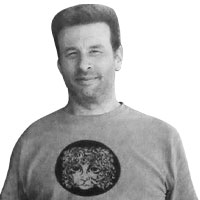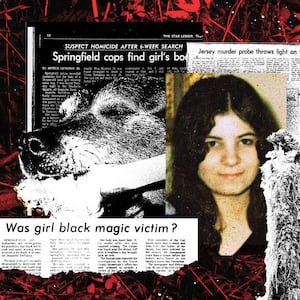Harry Edward Greenwell was “a man with many friends who loved his straight-up attitude, and his willingness to help anyone,” according to his 2013 obituary.
The 68-year-old—who spent three decades as a railroad track maintainer in Iowa before dying of cancer—enjoyed organic gardening, selling his produce at a local farmers’ market. He also liked traveling, reading, watching college sports and thoroughbred horse racing, and “wordsmithing,” the obit noted.
“His spirit will live on in many by [the] good deeds he offered,” it said.
ADVERTISEMENT
But Greenwell was also responsible for a string of far darker deeds, authorities announced Tuesday.
For years, investigators struggled to identify the so-called “Days Inn Killer,” also known as the “I-65 Killer,” who raped and murdered at least three women who worked as motel clerks in the 1980s, two of whom were on duty at two different Days Inns when they were attacked. But thanks to DNA and forensic genealogy, police said, they finally managed to crack the case—and believe Greenwell may have also been behind other murders, rapes, and assaults in states up and down the I-65 corridor that have never been solved.
“Law enforcement officers and detectives are taught to never give up and to follow where the facts lead them,” Lt. Matt Harris of the Columbus, Indiana, Police Department said at a press conference on Tuesday. “However, an experienced officer will trust their instincts as well. The smallest piece of evidence is often what breaks the case wide open.”
Greenwell had been arrested numerous times over the years and escaped from jail twice, cops said. Accordingly, his DNA was entered into the FBI’s Combined DNA Index System, or CODIS, but detectives weren’t able to link Greenwell to the Days Inn murders until mid-2019, thanks to advances in genealogical research techniques. And some 35 years later, investigators found their man.

Investigative, or forensic, genealogy, is what led to the infamous Golden State Killer’s capture in 2018. It relies on DNA to analyze family connections, which can then identify relatives of the potential suspect. From there, investigators can narrow down the possibilities, and hopefully zero in on the person they’re looking for.
The then-unsolved killings began on Feb. 21, 1987, when a guest at a Super 8 Motel in Elizabethtown, Kentucky, called police to report “a complete mess” in the lobby. The payphone had been ripped from the wall, furniture was overturned, and they couldn’t find the desk clerk, the caller said.
When cops arrived, they found the body of 41-year-old Vicki Heath, who worked nights at the motel, behind the dumpsters out back. She had been raped, robbed, beaten, and shot in the head.
Two years went by without a break in the case. Then, the I-65 Killer struck again. On March 3, 1989, 24-year-old Mary “Peggy” Gill, a night clerk at a Days Inn in Merrillville, Indiana, was found dead in a vacant section of the motel. The place had been robbed, and, like Heath, Gill had also been shot in the head.
Later that day, Jeanne Gilbert, a 33-year-old clerk at a Days Inn in Remington, Indiana, about 60 miles south of Merrillville, was found dead in a ditch near the motel. Like the others, Gilbert had been shot in the head by her killer.
In 1990, police in Elizabethtown were able to match DNA from the Heath murder to four similar cases in other states, including Minnesota and Illinois. All of the victims had been motel clerks along I-65, and each had been raped and robbed before being killed. Cops said they believed the murders were the work of a roving serial killer. But they still didn’t know who that DNA belonged to.
That same year, a woman working at a Days Inn in Columbus, Indiana, was sexually assaulted and stabbed, but managed to survive. For the first time, detectives were able to get a description of the killer, whom the unidentified woman described as a white man, about six feet tall, with greasy gray hair and a lazy right eye.

“What police don’t know is how many other people this man attacked or killed; where his trail begins or ended; whether this man is dead, alive, or already in jail somewhere,” Louisville, Kentucky, ABC affiliate WHAS reported in 2013.
“[M]ost of our murders are local or have some type of domestic tie or something,” Elizabethtown PD Det. Clinton Turner told the outlet. “Whereas this is a random murder and there are 16 million people that travel up and down 65 in a year’s time… I say there’s an 80 percent chance we could find him.”
On Tuesday, Jeanne Gilbert’s daughter, Kim Gilbert Wright, addressed a roomful of reporters as police officials announced they had identified Greenwell as the Days Inn Killer.
Wright, who is now a lawyer, called the news “pretty overwhelming.”
“Let me first thank everyone attending today to share in this monumental development that’s been long awaited by our family, the surviving victims,” Wright said. “The families of Peggy Gill and Vicki Heath, and also friends and families of the victims who have all been on this long journey with us.”

Jeanne Gilbert; Vicki Heath; and Margaret “Peggy” Gill
Indiana State PoliceWright also thanked those who took part in the genealogy searches that led to the discovery of Greenwell’s identity, making it possible for a DNA databank to be compiled and analyzed.
“In addition to our families, I believe [Greenwell’s] family and friends have also become victims of his crimes as well,” Wright continued. “While no one would ever think to blame them for what their husband, father, brother, or friend did, they will now likely feel judged in the court of public opinion for his deeds and we must feel for them as they likely never knew the person that he truly was nor of the horrific acts that he was capable of.”
Wright said she tries not to refer to Gilbert in the past tense, “so she’s still here in my heart… We talk about her as if she isn’t gone.”
She and her brother lived with their mom for the last seven months of her life, and said she will never forget her last words.
“I love you,” Gilbert told the pair as she left for work that fateful night. “I’ll see you tomorrow.”
However, as Wright said, “I didn’t see her that tomorrow. But I see her every day. I see her in me. I see her in my brother. I see her in my family. And… I encourage everyone else to celebrate her.”






